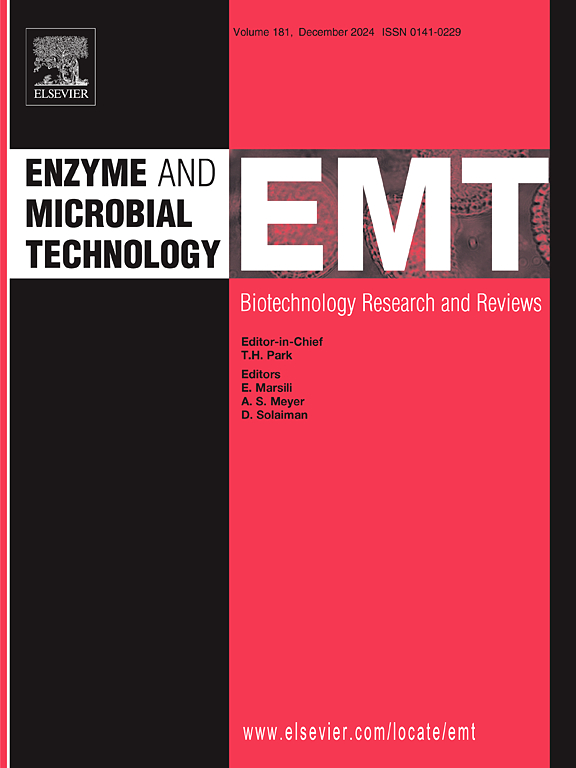n-杂环化合物:生产优化、生物活性评价及与炎症、肥胖、糖尿病和胰岛素信号通路相关的关键酶的硅对接
IF 3.7
3区 生物学
Q2 BIOTECHNOLOGY & APPLIED MICROBIOLOGY
引用次数: 0
摘要
众所周知,糖尿病会引起严重的胰腺炎症并降低胰岛素水平,这促使我们研究了从粘质沙雷氏菌中提取的一种红色杂环细菌化合物——prodigiosin (PG)的作用。优化了提取PG的理化条件和营养条件,并对提取溶剂进行了优化。PG经细菌培养制备,高效液相色谱(HPLC)和薄层色谱(TLC)纯化,傅里叶变换红外光谱(FTIR)和紫外光谱(UV)表征。在体外,PG以剂量依赖的方式有效抑制关键炎症酶,如磷脂酶A2 (PLA2)和弹性酶(ELA),在浓度为320 µg/mL时,其最大抑制率为85.3和91.4 %,IC₅0值分别为63 µg/mL和54.7 µg/mL。PG对髓过氧化物酶(MPO)的最大抑制率为82.4 %,浓度为160 µg/mL, IC₅₀值为25.9 µg/mL。这表明PG是治疗这两种代谢性疾病的良好候选药物。此外,PG通过其刺激蛋白酪氨酸磷酸酶1B (PTP1B)和抑制二肽基肽酶4 (DPP-4)的能力显示出激活胰岛素信号的显着能力,与特定抑制剂CLM和STG (IC₅0值分别为19和27 μ g/mL)相比,IC₅0值分别为67和28 µg/mL。通过测定结合能、配体效率和估计的抑制常数(Ki),证实了PG对这些酶的强大亲和力、稳定性和持久性。结论:PG受益于可持续的、具有成本效益的生物生产,并具有有效的抗炎、抗氧化和抗糖尿病特性,在制药和食品领域具有广阔的应用前景。本文章由计算机程序翻译,如有差异,请以英文原文为准。
Prodigiosin As N-heterocyclic compound: Production optimization, bioactivity evaluation, and in-silico docking against key enzymes related to inflammation, obesity, diabetes, and the insulin signaling pathway
Diabetes is known to cause severe pancreatic inflammation and reduce insulin levels, leading us to investigate the effects of prodigiosin (PG), a red, heterocyclic bacterial compound extracted from Serratia marcescens. The physicochemical and nutritional conditions, along with the extraction solvents for PG, have been optimized for efficient production. PG was produced through bacterial culture, purified by high-performance liquid chromatography (HPLC) and thin-layer chromatography (TLC), characterized by Fourier-transform infrared spectroscopy (FTIR) and ultraviolet (UV) spectroscopy. In vitro, PG effectively inhibited key inflammatory enzymes, such as phospholipase A2 (PLA2) and elastase (ELA), in a dose-dependent manner, achieving maximum inhibition rates of 85.3 and 91.4 % at concentrations of 320 µg/mL, with IC₅₀ values of 63 µg/mL and 54.7 µg/mL, respectively. PG also exhibited a maximum inhibition of 82.4 % for myeloperoxidase (MPO) at a concentration of 160 µg/mL, with an IC₅₀ value of 25.9 µg/mL. This indicates that PG is a good candidate for treating these two metabolic diseases. Moreover, PG shows a significant ability to activate insulin signaling through its capacity to stimulate protein tyrosine phosphatase 1B (PTP1B) and inhibit dipeptidyl peptidase-4 (DPP-4), with IC₅₀ values of 67 and 28 µg/mL, respectively, compared to the specific inhibitors CLM and STG (with IC₅₀ values of 19 and 27 µg/mL, respectively). These powerful affinities, stability, and the durability of PG inhibition of these enzymes are confirmed by the determination of binding energy, ligand efficiency, and estimated inhibition constant (Ki). Conclusion: PG benefits from sustainable, cost-effective biological production and exhibits potent anti-inflammatory, antioxidant, and anti-diabetic properties, positioning it as a promising candidate for pharmaceutical and food applications.
求助全文
通过发布文献求助,成功后即可免费获取论文全文。
去求助
来源期刊

Enzyme and Microbial Technology
生物-生物工程与应用微生物
CiteScore
7.60
自引率
5.90%
发文量
142
审稿时长
38 days
期刊介绍:
Enzyme and Microbial Technology is an international, peer-reviewed journal publishing original research and reviews, of biotechnological significance and novelty, on basic and applied aspects of the science and technology of processes involving the use of enzymes, micro-organisms, animal cells and plant cells.
We especially encourage submissions on:
Biocatalysis and the use of Directed Evolution in Synthetic Biology and Biotechnology
Biotechnological Production of New Bioactive Molecules, Biomaterials, Biopharmaceuticals, and Biofuels
New Imaging Techniques and Biosensors, especially as applicable to Healthcare and Systems Biology
New Biotechnological Approaches in Genomics, Proteomics and Metabolomics
Metabolic Engineering, Biomolecular Engineering and Nanobiotechnology
Manuscripts which report isolation, purification, immobilization or utilization of organisms or enzymes which are already well-described in the literature are not suitable for publication in EMT, unless their primary purpose is to report significant new findings or approaches which are of broad biotechnological importance. Similarly, manuscripts which report optimization studies on well-established processes are inappropriate. EMT does not accept papers dealing with mathematical modeling unless they report significant, new experimental data.
 求助内容:
求助内容: 应助结果提醒方式:
应助结果提醒方式:


